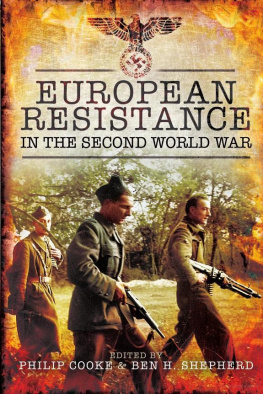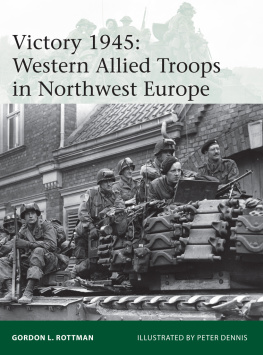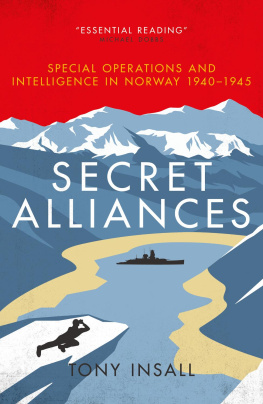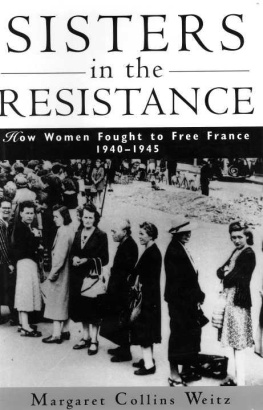
THE RESISTANCE IN WESTERN EUROPE, 19401945
European Perspectives
EUROPEAN PERSPECTIVES
A SERIES IN SOCIAL THOUGHT AND CULTURAL CRITICISM
Lawrence D. Kritzman, Editor
European Perspectives presents outstanding books by leading European thinkers. With both classic and contemporary works, the series aims to shape the major intellectual controversies of our day and to facilitate the tasks of historical understanding.
For a complete list of books in the series, see .
The Resistance in Western Europe, 19401945
Olivier Wieviorka
TRANSLATED BY
Jane Marie Todd
Columbia University Press
New York
Columbia University Press
Publishers Since 1893
New York Chichester, West Sussex
cup.columbia.edu
Translation copyright 2019 Columbia University Press
Une histoire de la resistance en Europe occidentale 19401945 copyright 2017 Perrin, a department of Edi8
All rights reserved
E-ISBN 978-0-231-54864-9
Library of Congress Cataloging-in-Publication Data
Names: Wieviorka, Olivier, 1960- author. | Todd, Jane Marie, 1957 translator.
Title: The resistance in Western Europe, 1940-1945 / Olivier Wieviorka; translated by Jane Marie Todd.
Other titles: Histoire de la r sistance en Europe occidentale. English.
Description: Columbia University Press : New York, [2019] | Includes bibliographical references and index.
Identifiers: LCCN 2019006017| ISBN 9780231189965 (cloth : alk. paper)
Subjects: LCSH: World War, 1939-1945Underground movementsEurope, Western. | GuerrillasEurope, WesternHistory20th century. | Europe, WesternHistory, Military20th century.
Classification: LCC D802.E85 W5413 2019 | DDC 940.53/4dc23
LC record available at https:// lccn .loc .gov /2019006017
A Columbia University Press E-book.
CUP would be pleased to hear about your reading experience with this e-book at .
Cover design: Julia Kushnirsky
Cover art: French Resistance fighters deal with Nazi snipers Bettmann/Getty Images
Columbia University Press gratefully acknowledges the generous contribution to this book provided by the Florence Gould Foundation Endowment Fund for French Translation.
For Pascale and Sophie
Contents
Robert O. Paxton
ROBERT O. PAXTON
G eneral Dwight D. Eisenhower, commander of the Allied Expeditionary Forces in Western Europe in 19441945, recalled afterward with gratitude how the French resistance had helped him in Normandy. It was the equivalent, he wrote, of fifteen divisions. No doubt he was benevolently handing out postvictory laurels. It is in fact quite difficult to measure with precision how much the resistance contributed to Allied victory. This authoritative account by the French historian Olivier Wieviorka expertly sums up the matter.
Familiar images of the resistance are colored by dramatic scenes of midnight train derailments and parachute receptions, images derived from novels, films, and personal reminiscences that could be a bit inflated. I remember discovering at the age of ten my parents copy of John Steinbecks novel The Moon Is Down (1942). I devoured this tale of an indomitable town in a country that resembles Norway, where Nazi executions only provoked further acts of sabotage. A translation of Steinbecks novel was published clandestinely in occupied France. Other translations appeared throughout Europe, and even in the Soviet Union.
Olivier Wieviorka has not written that kind of adventure story. His book is the best survey we have of how citizens across Nazi-occupied Western Europe formed and ran clandestine resistance organizations, how these interacted with the Allied military staffs in London, and what they were able to accomplish together. The Allies welcomed these organizations and gave them money and weapons. But they feared unleashing premature risings that could end only in futile bloodshed. Above all they wished to avoid setting off the social revolutions desired by some resisters. Inevitably conflicts arose between London and the various national undergrounds on the Continent. Wieviorka explains how these conflicts were resolved in ways that made effective action possible.
Wieviorkas focus on the six occupied countries of Western EuropeFrance, Belgium, Holland, Norway, Denmark, and Italyis a fruitful one. Most books about the opposition to Nazi occupation treat individual nations, and logically so, since resistance movements, striving for national liberation, were inherently national. A continental focus shows that the six nations faced problems common to all of occupied Western Europe but came up with distinctive national responses. Wieviorkas continental perspective also matches that of the Allied staffs in London who were planning to invade Hitlers Fortress Europe.
So this book is as richly informative about the Allies as about the resistance. It examines more fully than any previous work the complicated three-way negotiations among the Anglo-American authorities; the exiled governments of France, Holland, Belgium, and Norway in London; and the underground movements that together made it possible to plan and execute clandestine operations.
Wieviorka omits the anti-Hitler resistance within Germany, and quite reasonably so, for the unique moral and physical obstacles it faced made it a different story. Eastern Europe constitutes another different story. Occupation regimes there were harsher, and resistance movements were more closely related to the gigantic armed clashes of the Russian front.
Resistance movements probably had more impact in Eastern Europe than in the West. After the German invasion of the Soviet Union in June 1941, the Soviet military leadership actively encouraged partisan activity behind the German lines. Eventually some 250,000 irregulars harassed German supply lines and created a climate of insecurity in the German Armys rear. In the Yelnya-Dorogobash area (today in Belarus), all or parts of nine Germans divisions were involved in trying to suppress partisan activities in May-June 1942. But even there the partisans could not by themselves change the course of the war. Elsewhere, the Polish Home Armys celebrated effort to liberate Warsaw, beginning on August 1, 1944, only to be crushed by the German Army as Soviet forces waited on the opposite bank of the Vistula River, showed once again that underground forces alone could not liberate territory. Similarly, a German decision on August 29, 1944, to occupy militarily the satellite country of Slovakia set off a rising by resistance forces that at first freed large sections of the country. In the absence of effective aid from nearby Russian forces, however, the Germans recaptured these areas by the end of October. Only the Yugoslav leader Josip Broz Tito succeeded in freeing some territory from German control in the absence of regular Allied armies. These immense and sanguinary sagas of partisan warfare in Eastern Europe remain offstage in this book, as does of course the whole Pacific dimension of World War II.
Nevertheless, the Western European resistance movements were important enough to engage the Nazi occupation authorities in intensive efforts to destroy them. Their role in the liberation and in postwar Europe was not limited to sabotage. Resisters performed other, no less dangerous and indispensable, functions. They collected and transmitted intelligence about Axis forces; countered Axis propaganda with clandestine publications and symbols, like chalking V for victory on walls (the occupation authorities erased fifty-five hundred of these in Lille, in northern France, on March 21, 1941); and smuggled downed Allied pilots to safety.
Resistance movements in occupied Western Europe were of course not homogeneous. They contained multiple, sometimes conflicting strands. Before Hitlers invasion of the Soviet Union on June 22, 1941, the Communist parties in these areas operated illegally underground, but they were not pro-Allied, in accordance with Stalins scrupulous adherence to the Nazi-Soviet Pact of August 1939. Their entry into active anti-German resistance in June 1941 forms a major turning point in this story. Habituated to clandestinity, ready for sacrifice, Communists came to play a leading role in Western European resistance movements. A Communist revolution, however, was never in the cards. Joseph Stalin, in desperate straits, was more interested in an early Anglo-American landing in the West, to relieve the pressure on his front, than in promoting immediate social revolution in Western Europe.
Next page









